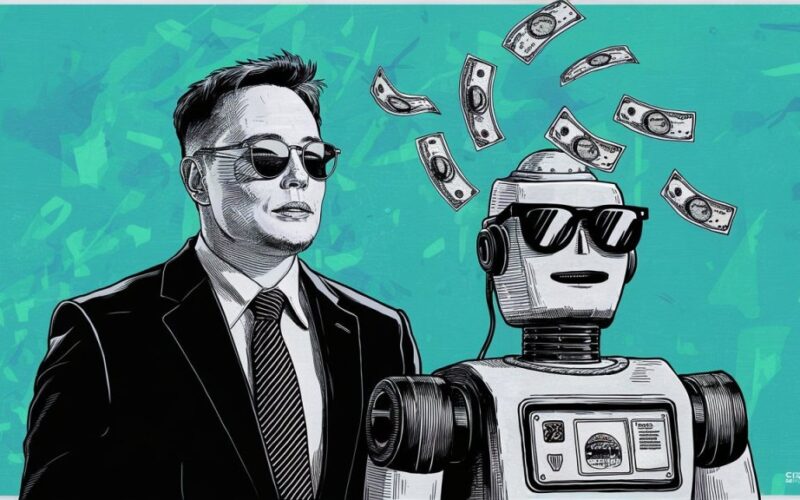Join us in returning to NYC on June 5th to collaborate with executive leaders in exploring comprehensive methods for auditing AI models regarding bias, performance, and ethical compliance across diverse organizations. Find out how you can attend here.
Today, Elon Musk’s xAI startup announced a massive $6 billion round of funding.
Confirming reports from April, the series B investment comes from the participation of multiple known venture capital firms and investors, including Valor Equity Partners, Vy Capital, Andreessen Horowitz (A16z), Sequoia Capital, Fidelity Management & Research Company, Prince Alwaleed Bin Talal and Kingdom Holding, amongst others.
Musk said the funding has been raised at a pre-money valuation of $18 billion.
While it is not uncommon to see massive rounds and valuations for young startups in the AI space, this development is unique due to the sheer size of the capital involved – possibly one of the largest series B investments ever made in the category.
xAI, which has been moving aggressively with its Grok-1 model and chatbot, hopes to use the money to accelerate its work and better take on OpenAI, Anthropic, Google and others in the race for artificial generalized intelligence (AGI).
“There will be more to announce in the coming weeks,” Musk wrote on X.
Musk’s aggressive push with xAI and Grok
Notably, Musk co-founded OpenAI alongside its current CEO Sam Altman and president Greg Brockman and others back in 2015 but broke with the company over its priorities and direction in 2018, leaving it and ultimately turning into one of its staunchest critics — specifically over its move away from open source AI models and toward “closed” or proprietary models to which it sells access.
Musk formally re-entered the generative AI space with the announcement of xAI in July last year. Since then, the company has been moving aggressively towards building advanced AI systems that are “truthful, competent, and maximally beneficial for all of humanity.”
The company launched Grok-1 in November 2023, saying the AI has been modeled after “The Hitchhiker’s Guide to the Galaxy” and can answer almost anything to assist humanity in its quest for understanding and knowledge – regardless of background or political views.
On benchmarks such as GSM8K, HumanEval and MMLU, shared by xAI, Grok-1 outperformed Llama-2-70B and GPT-3.5 but lagged behind leading models such as Anthropic’s Claude3, OpenAI’s GPT-4, Google’s Gemini, and Meta’s open source Llama 3.
Over the subsequent months, the company expanded access to the model via Grok chatbot – making it available to paying Premium and Premium+ subscribers on Musk’s separate social network X – and highlighted how it can provide answers using the latest data from X posts while being witty, funny or sarcastic at the same time. Even
Musk kept highlighting Grok’s unique sense of humor, despite many flagging cases of hallucinations at the same time.
In March this year, the company again started shifting gears. It first made Grok-1 open-source and then launched its better-performing successors — Grok-1.5 and Grok-1.5V.
Grok-1.5 introduced enhanced reasoning and problem-solving capabilities and closed in on the performance of known open and closed LLMs, including GPT-4 and Anthropic’s Claude 3.
Meanwhile, Grok-1.5V added multimodality with the ability to understand things seen in documents, diagrams, charts, screenshots and photographs. Around the same time, The Information reported that the company is in talks with investors to raise $6 billion.
Now, with the funding officially announced, xAI is expected to use it on graphics processing unit (GPU) clusters as well as hiring to enhance the capabilities of Grok.
That would make it a more direct competitor for OpenAI’s ChatGPT, which recently got a big upgrade with a new GPT-4o model that reasons across text, voice and vision in real-time. Google too has been pushing the bar on Gemini’s multimodal capabilities.
“xAI will continue on this steep trajectory of progress over the coming months, with multiple exciting technology updates and products soon to be announced. The funds from the round will be used to take xAI’s first products to market, build advanced infrastructure and accelerate the research and development of future technologies,” the company wrote in a blog post.
An xAI supercomputer by 2025?
While it remains to be seen what updates to Grok are in the pipeline, the work on the infrastructure side is likely to revolve around a massive supercomputer. According to another report by The Information, Musk told investors that he wants to get this GPU cluster or “gigafactory of compute” ready by the fall of 2025.
The system will reportedly use Nvidia’s H100 GPUs and would be at least four times the size of the biggest GPU clusters that have been built to train and run highly-performant AI models, he said.
Notably, OpenAI and Microsoft are also reported to be planning a massive AI supercomputer. According to initial estimates, the project, dubbed Stargate, will use millions of specialized chips to power OpenAI’s models and could cost up to $100 billion. Back in March, Musk sued OpenAI for abandoning its founding mission and becoming a closed-source de-facto subsidiary of Microsoft developing AGI for profits rather than the benefit of humanity.
Source link
lol

